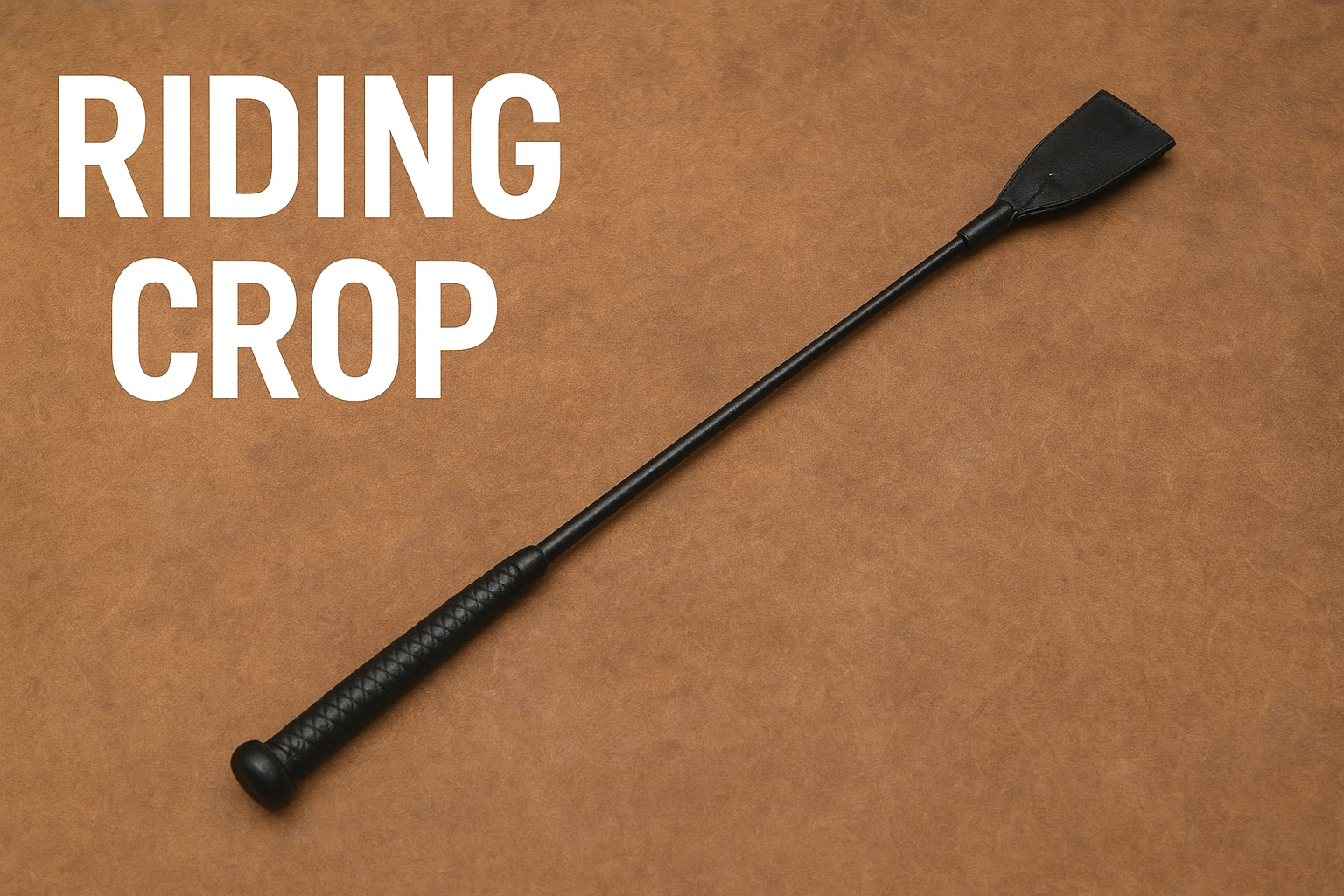Horseback riding is an activity built on trust, communication, and coordination between rider and horse. To achieve smooth control and effective communication, equestrians rely on several aids—body position, voice, reins, and sometimes a riding crop. This tool, though small, holds a significant role in helping riders guide and communicate with their horses. To understand it fully, this article explores its history, parts, proper usage, and importance, making it accessible to both beginners and curious learners.
What Is a Riding Crop?
A riding crop is a short, flexible tool used in horseback riding to reinforce the rider’s cues and commands. It typically measures between 24 and 30 inches and consists of a sturdy yet flexible shaft, a handle, and a small leather flap or “keeper” at the end. Unlike a whip, which is longer and designed for different types of control, the riding crop is compact and precise.
It’s important to understand that a riding crop is not meant for punishment. Instead, it serves as a communication tool that emphasizes leg or rein signals, ensuring the horse responds effectively. For instance, when a rider asks the horse to move forward and the horse hesitates, a light tap from the crop acts as a reminder—not a punishment—to follow the cue.
The History of the Riding Crop
The riding crop has a rich history that dates back centuries. In ancient times, early riders and charioteers used simple switches made of reeds or flexible branches to guide horses. These primitive tools evolved into more sophisticated versions as horsemanship became both an art and a necessity for travel, war, and sport.
By the 17th and 18th centuries, crops were commonly used by cavalry officers and aristocrats who took pride in their horses. The designs became ornate, featuring silver handles, fine leather, and custom craftsmanship. Over time, as horseback riding transformed into a sport and leisure activity, the crop evolved to prioritize functionality and humane use rather than decoration.
Today, modern crops focus on comfort, efficiency, and ethical design, ensuring that they support communication rather than control through force.
Parts of a Riding Crop
Every part of a riding crop is designed with purpose and precision. Understanding its structure helps riders use it correctly and responsibly.
Handle
The handle provides grip and stability. It is often covered in leather or rubber and may include a wrist loop to prevent accidental dropping.
Shaft
The shaft forms the main body of the crop. It is typically made from flexible materials like carbon fiber, fiberglass, or nylon, allowing it to bend slightly when used.
Keeper
The keeper, or tip, is a flat piece of leather or synthetic material attached to the end of the shaft. It creates a light sound and sensation to signal the horse.
Cap
The cap sits at the end of the handle and serves as a counterbalance, improving the crop’s overall control and feel.
Each of these components contributes to a tool that’s both practical and humane when used correctly.
The Purpose of a Riding Crop
The riding crop plays an important role in communication. Horses are highly intelligent animals that respond to consistent, clear cues. While riders use their legs and reins to guide the horse, the crop reinforces these commands when necessary.
For example, when a horse delays responding to a leg cue to move forward, a gentle tap from the crop reinforces the signal. This helps the horse understand what the rider expects, leading to improved coordination and discipline over time.
The crop can also:
Encourage forward movement.
Reinforce cues during jumping or dressage.
Help develop the horse’s responsiveness.
Serve as a subtle reminder, not a punishment.
In short, the crop enhances communication between horse and rider, ensuring mutual understanding and trust.
Types of Riding Crops
Different riding disciplines require specific tools. Although all crops share the same purpose, their designs and lengths can vary based on how and where they are used.
Standard Crop
This is the most common type, used in everyday riding. It is balanced, easy to handle, and ideal for beginners.
Jumping Crop
Shorter and sturdier, the jumping crop is used in show jumping. It allows the rider to maintain control while moving at high speeds and clearing obstacles.
Dressage Whip
While not technically a crop, this whip is used in dressage to provide gentle encouragement without requiring large arm movements. It is longer than a crop, usually around 40 inches.
Lunge Whip
This whip is used during groundwork to encourage movement while training from a distance. It is never used while riding.
Each type is designed for a specific style of training or performance, emphasizing precision and humane use.
How to Use a Riding Crop Correctly
Learning to use a riding crop properly is essential for safe and effective communication. It should always be used as a supportive tool rather than a disciplinary one.
Holding the Crop
Hold the crop in the same hand as your reins—typically your dominant hand. The handle should rest firmly in your palm, and the shaft should lie across your thigh.
Timing the Cue
Use your crop immediately after your leg cue if the horse does not respond. The timing ensures that the horse associates the tap with the command, reinforcing positive behavior.
Using Gentle Pressure
The tap should be light, aimed just behind your leg, never on sensitive areas like the face or flank. Excessive force can damage trust and cause fear.
Rewarding Good Behavior
When the horse responds correctly, follow up with praise or a pat. Reinforcement builds confidence and strengthens your connection.
By maintaining patience and consistency, riders can ensure that the crop serves as a helpful and ethical training aid.
Safety and Ethical Use
Safety and respect for the horse always come first. Misusing a crop can harm the animal physically or emotionally. To maintain proper etiquette:
Always stay calm and composed while riding.
Never use the crop out of anger or frustration.
Avoid using it excessively or repeatedly.
Keep your strikes light and intentional.
Regularly check your crop for damage before use.
Ethical riders understand that the horse’s comfort and well-being matter most. The crop is only a tool to clarify communication—not to dominate.
Common Misunderstandings About Riding Crops
Despite their purpose, crops are often misunderstood. Some people assume they are used to punish horses, but in reality, proper riders use them as reinforcement aids. In professional equestrianism, improper use is strictly prohibited.
Another common misconception is that crops are outdated. However, they remain vital tools in modern riding when used responsibly. Even experienced riders rely on crops for subtle communication and guidance.
Lastly, it’s important to note that a riding crop is not required for all riders or situations. Some horses respond perfectly well to leg cues alone, while others may need occasional reminders.
Caring for a Riding Crop
Proper maintenance extends the lifespan of a crop and keeps it safe for use. Simple care habits include:
Wiping it clean with a damp cloth after rides.
Storing it in a dry place away from direct sunlight.
Checking for cracks or wear in the shaft and keeper.
Replacing it if the shaft becomes brittle or the keeper frays.
Taking care of your riding tools shows respect for the craft and ensures safety for both you and your horse.
Riding Crop vs. Whip
While both tools may look similar, they serve different functions. A riding crop is shorter and designed for precise cues during mounted riding. A whip, on the other hand, is longer and used mainly for training or groundwork.
The main difference lies in the reach and flexibility: crops offer control and accuracy, while whips provide distance and subtlety. Each tool has its place depending on the rider’s needs and discipline.
When to Use a Riding Crop
A crop should be used sparingly and only when necessary. Ideal situations include:
When a horse ignores leg cues.
During training sessions to refine performance.
When a reminder is needed for focus and obedience.
However, riders should always rely primarily on body cues and voice commands. Overusing a crop can make the horse dependent on it, which weakens communication skills.
The Role of Crops in Competitive Riding
In competitive equestrian sports such as show jumping, eventing, and dressage, crops are often allowed within strict guidelines. They serve as precise aids to support performance and timing.
For instance, in show jumping, a well-timed tap can encourage a horse to take off at the right moment. In dressage, the crop helps refine movements and improve responsiveness.
However, organizations like the FEI (Fédération Equestre Internationale) enforce strict rules regarding crop length and use to ensure fair and humane treatment of horses.
Modern Designs and Innovations
Today’s riding crop designs combine traditional craftsmanship with modern materials. Manufacturers use lightweight carbon fiber shafts, ergonomic grips, and synthetic keepers to increase comfort and control. Some crops even feature reflective coatings for visibility during evening rides.
These innovations focus on making riding safer, more efficient, and more ethical while maintaining the crop’s essential purpose as a communication aid.
Building Trust With Your Horse
Trust is the foundation of all riding. A horse that trusts its rider responds more confidently and willingly. The crop should never create fear—it should build understanding.
To develop trust:
Always stay gentle and patient.
Use the crop consistently but sparingly.
Combine it with rewards, calm voice, and kind gestures.
Recognize that every horse has a unique personality and sensitivity.
When trust exists, even the lightest tap becomes an effective cue, leading to harmony between horse and rider.
Final Thoughts
The riding crop represents more than just a tool—it symbolizes balance, control, and communication between human and horse. When used with knowledge, respect, and compassion, it enhances the relationship rather than undermines it.
Riders should always remember that mastery in equestrianism comes not from domination but from understanding and partnership. The crop’s true value lies in the gentle guidance it provides, not the power it wields.

